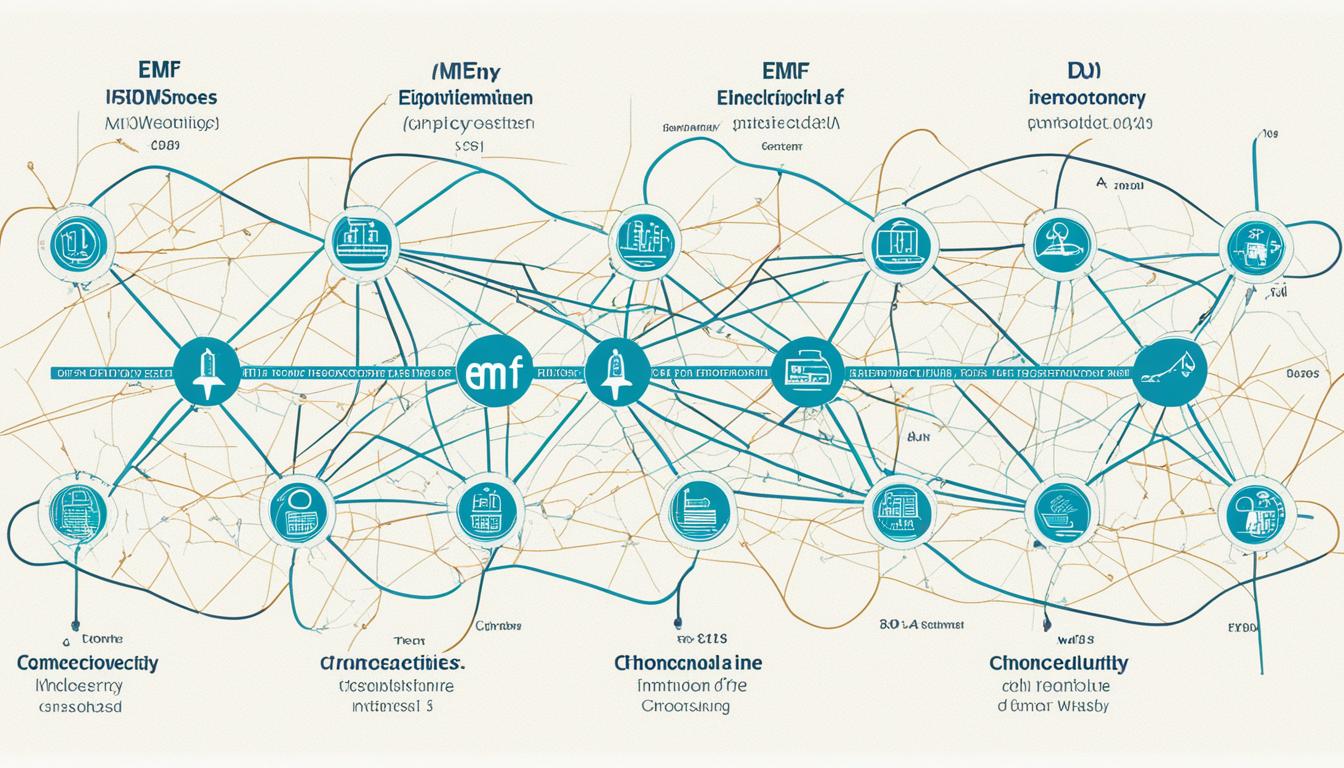Disclosure: This Post Contains Affiliate Links; We earn a commission on purchases.
Technology has come a long way over the centuries, revolutionizing every aspect of our lives. From the ancient discovery of static electricity to the development of today’s cutting-edge gadgets, we have witnessed remarkable advancements. However, with every stride forward, there are potential consequences. One such concern is the impact of electromagnetic fields (EMF) on our health and well-being.
EMF, a result of technological progress, is generated by various electronic devices and wireless communication systems. As we continue to immerse ourselves in this digital world, it’s crucial to understand the potential risks associated with EMF exposure.
Key Takeaways:
- Technology has evolved significantly, bringing convenience and efficiency to our lives.
- EMF is a byproduct of technological advancements and is generated by electronic devices and wireless communication systems.
- Understanding the potential risks of EMF exposure is important for our overall well-being.
- EMF protection devices are available to mitigate potential health risks.
- Further research is necessary to fully comprehend the impact of EMF on human health.
The Development of Electric and Magnetic Phenomena
The understanding and utilization of electric and magnetic phenomena have evolved over time. From the discovery of static electricity in ancient Greece to the invention of the voltaic pile by Alessandro Volta, significant milestones have paved the way for the advancements in electrical science.
Static electricity:
Static electricity, known since ancient times, is the build-up of electric charge on the surface of objects caused by unequal distribution of electrons. While its practical applications were limited in the past, the discovery of static electricity laid the foundation for further exploration of electricity and magnetism.
Voltaic pile:
In 1800, Alessandro Volta invented the voltaic pile, a device capable of generating a continuous electric current by chemical reactions. This invention marked a significant step forward in harnessing electrical energy and opened doors for future innovations in the field of electricity.
“The discovery of static electricity and the invention of the voltaic pile were pivotal moments that led to further advancements in electric and magnetic phenomena.”
Electric lights:
The development of electric lights revolutionized the way we illuminate our surroundings. Thomas Edison’s invention of the practical incandescent light bulb in 1879 paved the way for the widespread adoption of electric lighting, enabling safer and more efficient illumination in homes, streets, and workplaces.
Power generators:
Power generators are critical in converting mechanical energy into electrical energy. A breakthrough innovation was the development of the practical power generator by Michael Faraday in the early 19th century. This invention laid the groundwork for the generation of electricity on a large scale, powering entire cities and facilitating the expansion of industries.
Electric motors:
Electric motors, which can convert electrical energy into mechanical motion, were a major milestone in the evolution of electric and magnetic phenomena. In 1821, Michael Faraday and Joseph Henry independently discovered electromagnetic induction, paving the way for the development of electric motors. These motors have since become an integral part of various devices and industries, propelling advancements in technology.
The Impact of Radiofrequency Fields
The application of radiofrequency fields in wireless communication has revolutionized our ability to connect and transmit information. From the experiments conducted by Heinrich Hertz in the late 19th century to today’s widespread use of cellular telephones, radiofrequency technology has advanced rapidly.
However, alongside the benefits of wireless communication, concerns have emerged regarding the potential health risks associated with radiofrequency radiation. While there is currently no conclusive scientific evidence linking cell phone use to adverse health effects, ongoing research aims to better understand the impact of radiofrequency fields on human health.
As a response to these concerns, EMF (electromagnetic field) shielding solutions have been developed to mitigate potential risks. These solutions aim to reduce exposure to radiofrequency radiation and provide a sense of security for individuals who are worried about the potential health effects of wireless communication.
Understanding Radiofrequency Radiation
Radiofrequency radiation is a form of non-ionizing electromagnetic radiation that is used in various wireless communication devices, including cell phones, Wi-Fi routers, and Bluetooth devices. It falls within the lower-frequency range of the electromagnetic spectrum, with frequencies typically ranging from 3 kilohertz (kHz) to 300 gigahertz (GHz).
While radiofrequency radiation is generally considered safe in low levels, long-term exposure to high levels of radiation may pose potential health risks. Some individuals may experience symptoms such as headaches, fatigue, or sleep disturbances after prolonged use of wireless devices.
EMF Shielding Solutions
EMF shielding solutions help reduce exposure to radiofrequency radiation by blocking or redirecting the electromagnetic fields emitted by wireless communication devices. These solutions come in various forms, including:
- EMF shielding phone cases
- EMF shielding fabrics and clothing
- EMF shielding paint
- EMF shielding window films
These products are designed to create a barrier between the wireless device and the user, minimizing the electromagnetic field exposure.
| EMF Shielding Solution | Description |
|---|---|
| EMF Shielding Phone Cases | These specialized phone cases contain materials that help block or redirect radiofrequency radiation emitted by cell phones. They can be easily attached to the phone for added protection. |
| EMF Shielding Fabrics and Clothing | These fabrics are woven with conductive materials that can block or reduce radiofrequency radiation. They can be used to make EMF shielding clothing, blankets, or curtains. |
| EMF Shielding Paint | This paint contains conductive materials that can help reduce or block radiofrequency radiation. It can be applied to walls, ceilings, or other surfaces to create an EMF shielding barrier. |
| EMF Shielding Window Films | These films are applied to windows and can block a significant amount of radiofrequency radiation from entering a building. They are transparent and do not obstruct the view. |
By incorporating these EMF shielding solutions into daily life, individuals can take proactive steps to reduce their exposure to radiofrequency radiation and alleviate concerns about potential health risks.
The Concerns About EMF Exposure
Over the years, scientific research on EMF exposure has focused on various sources, including power lines and cell phones. While some studies have shown a possible link between EMF field strength and increased risk for childhood leukemia, the evidence is considered weak. Studies on adults have not found a connection between EMF exposure and adult cancers such as leukemia, brain cancer, and breast cancer. However, with the proliferation of wireless devices and the internet of things, concerns persist about the potential health effects of EMF exposure.
Further research is needed to fully understand the impact of EMF on human health.
EMF Research
Scientists and researchers around the world are actively studying the effects of EMF on human health. They are investigating various aspects of EMF exposure, including the potential risks associated with cell phone radiation, power line proximity, and other sources of electromagnetic radiation. These studies aim to provide a comprehensive understanding of the health effects of EMF exposure and inform the development of safety guidelines and regulations.
Health Effects
While the research on EMF health effects is still ongoing, some studies have suggested potential associations between EMF exposure and certain health conditions. For example, there have been concerns about the impact of long-term cell phone radiation on brain function and the development of brain tumors. However, the scientific evidence remains inconclusive, and more research is needed to establish clear causality and determine the extent of these health effects.
It is important to note that the majority of scientific studies have not found a direct link between EMF exposure and adverse health effects. Regulatory bodies and health organizations, such as the World Health Organization (WHO) and the International Commission on Non-Ionizing Radiation Protection (ICNIRP), continue to monitor and assess the latest research findings to provide evidence-based guidelines on EMF exposure.
Power Line Proximity
Power lines are a common source of EMF exposure, especially for individuals living in close proximity to high-voltage transmission lines. Concerns have been raised about the potential health effects of prolonged exposure to EMF generated by power lines. Some studies have suggested a possible association between power line proximity and an increased risk of childhood leukemia. However, the findings have been inconsistent, and the overall evidence remains limited and inconclusive. More research is needed to determine the relationship between power line proximity and health outcomes.
It is worth noting that governments and utility companies have implemented safety measures to minimize the potential risks of EMF exposure from power lines. These measures include maintaining safe distances between power lines and residential areas, implementing shielding techniques, and adhering to regulatory guidelines.
While concerns about EMF exposure persist, it is important to approach the topic with a balanced perspective and rely on scientifically validated information. Understanding the current research landscape and staying informed about the latest developments in EMF research can help individuals make informed decisions regarding their own health and well-being.

The Basics of EMF Radiation
Understanding the different types of electromagnetic field (EMF) radiation is essential in assessing potential health risks and implementing effective protection measures. EMF radiation can be categorized into non-ionizing and ionizing radiation, with each type having distinct characteristics and implications for human health.
Non-Ionizing Radiation
Non-ionizing radiation refers to electromagnetic waves with low energy levels that do not have enough force to remove tightly bound electrons from atoms or molecules. Non-ionizing radiation includes extremely low frequency (ELF) radiation and radiofrequency (RF) radiation.
ELF radiation is commonly emitted by power lines, electrical appliances, and some electronic devices. RF radiation is predominantly associated with wireless communication devices, such as cell phones, Wi-Fi routers, and Bluetooth devices.

Ionizing Radiation
Ionizing radiation, on the other hand, possesses enough energy to remove electrons from atoms or molecules, leading to cellular and DNA damage. This type of radiation includes X-rays, gamma rays, and some forms of ultraviolet (UV) radiation.
While EMF radiation falls into the non-ionizing category, long-term exposure to low-energy non-ionizing frequencies from electronic devices has been shown to have negative biological effects.
| Radiation Type | Classification | Energy Range | Examples |
|---|---|---|---|
| Non-Ionizing Radiation | Low energy | Extremely low frequency (ELF) and radiofrequency (RF) radiation | Power lines, electrical appliances, cell phones, Wi-Fi routers |
| Ionizing Radiation | High energy | X-rays, gamma rays, some UV radiation | Medical imaging, nuclear power, sun exposure |
Due to the potential health risks associated with long-term exposure, it is crucial to take measures to protect oneself from EMF radiation.
The Need for EMF Protection
“While non-ionizing radiation is generally considered harmless, long-term exposure to low-energy frequencies from electronic devices has the potential for negative biological effects.”
EMF protection devices have been developed to mitigate potential risks from EMF radiation. These devices work by reducing exposure to harmful radiation or by neutralizing its effects on the body. Common types of EMF protection devices include:
- EMF shielding materials: These materials block or redirect EMF radiation, reducing exposure.
- EMF-blocking phone cases and laptop shields: These cases and shields limit radiation emitted by electronic devices.
- EMF harmonizers: These devices claim to neutralize the harmful effects of EMF radiation by creating a protective field.
While the effectiveness of these devices varies, they provide an additional layer of protection for individuals concerned about the potential health risks associated with EMF radiation.
As the use of electronic devices and wireless technologies continues to grow, it is important to prioritize EMF protection to minimize potential health risks. By understanding the different types of EMF radiation and implementing appropriate protection measures, individuals can enjoy the benefits of modern technology while safeguarding their well-being.
Symptoms and Lasting Effects of EMF Exposure
Exposure to electromagnetic fields (EMF), especially to extremely low frequency (ELF) and radiofrequency (RF) radiation, has been linked to various health issues. The effects of EMF exposure can range from respiratory problems and cardiac issues to neurological effects and skin conditions.
Long-term exposure to EMF can have lasting effects on the body. It can lead to DNA damage, abnormal cell division, and impaired immune system function. Even low-level EMF radiation has been shown to impact human health, but the effects are more pronounced after prolonged and close-range exposure.
To minimize the potential health risks associated with EMF exposure, it is crucial to adopt proper EMF protection and avoidance strategies. This can include limiting exposure to electronic devices, using EMF shielding solutions, and creating healthy electromagnetic environments.
In conclusion, understanding the symptoms and lasting effects of EMF exposure empowers individuals to make informed decisions about their use of technology and take necessary precautions. By prioritizing EMF protection, we can safeguard our well-being and preserve a healthy balance between the benefits of technology and our overall health.
Conclusion
As technology continues to evolve at a rapid pace, it is essential for us to consider the potential impact of electromagnetic fields (EMF) on our health. While the future holds exciting advancements in technology, it is crucial that we prioritize safety and take measures to protect ourselves from EMF radiation.
One way to mitigate potential risks is through the use of EMF shielding solutions. These innovative technologies are designed to reduce our exposure to EMF radiation, providing an added layer of protection in an increasingly digital world. By adopting these shielding solutions, we can minimize the potential health effects associated with long-term EMF exposure.
In addition to implementing EMF shielding solutions, it is important for individuals and businesses to embrace best practices in digital transformation. This involves being proactive in managing EMF exposure and staying informed about the latest research in the field. By staying ahead of future tech trends and understanding the potential effects of EMF radiation, we can make informed decisions and safeguard our well-being in the digital age.
As we navigate the possibilities and opportunities of the digital era, it is vital to prioritize our health and take steps to minimize EMF exposure. By combining EMF shielding solutions with responsible digital transformation practices, we can embrace the future of technology while ensuring the well-being of ourselves and future generations.
Source Links
- https://www.emf-portal.org/en/cms/page/home/technology/general/historical-review
- https://www.niehs.nih.gov/health/topics/agents/emf
- https://defendershield.com/electromagnetic-radiation-studies

Subscribe to Our Newsletter










